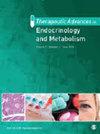Age-related markers and predictors of diabetic kidney disease progression in type 2 diabetes patients: a retrospective cohort study
IF 4.6
3区 医学
Q2 ENDOCRINOLOGY & METABOLISM
Therapeutic Advances in Endocrinology and Metabolism
Pub Date : 2024-04-06
DOI:10.1177/20420188241242947
引用次数: 0
Abstract
Background:Diabetic kidney disease (DKD) is characterized by reduced estimated glomerular filtration rate (eGFR) and albuminuria, which play a pivotal role in both diagnosing and determining the disease’s progression. This study aimed to assess the trajectory of these markers concerning age in individuals with DKD and identify predictive factors for the decline in eGFR decline, variation in albuminuria, mortality, and progression to renal replacement therapy (RRT).Design:This retrospective cohort encompassed patients with type 2 diabetes (T2D), divided into two age categories: <75 and ⩾75 years old.Methods:Over a 3-year span, the study evaluated eGFR (CKD-EPI) and 24-h albuminuria. Univariate and multivariate analyses were employed to pinpoint factors associated with deteriorating renal function and mortality. Significance was set at p < 0.05, and Kaplan–Meier survival curves were constructed to illustrate renal and overall survival.Results:The analysis comprised 304 patients. Comparable eGFR declines were evident in both age groups during the transition from the first to the second year and from the second to the third year. Nonetheless, a more pronounced rise in albuminuria was evident in the ⩾75 years group during the first to the second year. Multivariate analysis unveiled that systolic blood pressure (SBP) measurements in the first year positively forecasted eGFR decline. Age was associated with heightened albuminuria and mortality, while hospitalizations linked to cardiovascular causes robustly predicted mortality. Hospitalizations due to sepsis and cardiovascular reasons, coupled with first-year SBP measurements, served as predictive indicators for progression to RRT.Conclusion:Both age groups experienced similar declines in eGFR, though the ⩾75 years group displayed a more significant increase in albuminuria during the first to the second year. Age, hospitalizations, and higher blood pressure levels were correlated with exacerbated renal function deterioration and/or elevated mortality in DKD. Timely intervention and tailored management strategies stand as critical components for enhancing outcomes among DKD patients.2 型糖尿病患者糖尿病肾病进展的年龄相关指标和预测因素:一项回顾性队列研究
背景:糖尿病肾病(DKD)的特征是估计肾小球滤过率(eGFR)和白蛋白尿的降低,这两个指标在诊断和确定疾病进展方面起着关键作用。本研究旨在评估这些指标在 DKD 患者中与年龄相关的变化轨迹,并确定 eGFR 下降、白蛋白尿变化、死亡率和肾脏替代治疗(RRT)进展的预测因素。方法:在 3 年的时间里,本研究评估了 eGFR(CKD-EPI)和 24 小时白蛋白尿。采用单变量和多变量分析来确定与肾功能恶化和死亡率相关的因素。显著性设定为 p <0.05,并绘制了 Kaplan-Meier 生存曲线来说明肾功能和总生存率。在从第一年到第二年以及从第二年到第三年的过渡期间,两个年龄组的 eGFR 下降幅度相当。然而,从第一年到第二年,75 岁以上年龄组的白蛋白尿上升更为明显。多变量分析表明,第一年的收缩压(SBP)测量值可预测 eGFR 的下降。年龄与白蛋白尿和死亡率的增加有关,而与心血管疾病有关的住院治疗可有力地预测死亡率。结论:两个年龄组的 eGFR 下降幅度相似,但⩾75 岁组从第一年到第二年的白蛋白尿增加更为显著。年龄、住院和较高的血压水平与 DKD 患者肾功能恶化加剧和/或死亡率升高相关。及时干预和量身定制的管理策略是提高 DKD 患者预后的关键因素。
本文章由计算机程序翻译,如有差异,请以英文原文为准。
求助全文
约1分钟内获得全文
求助全文
来源期刊

Therapeutic Advances in Endocrinology and Metabolism
Medicine-Endocrinology, Diabetes and Metabolism
CiteScore
7.70
自引率
2.60%
发文量
42
审稿时长
8 weeks
期刊介绍:
Therapeutic Advances in Endocrinology and Metabolism delivers the highest quality peer-reviewed articles, reviews, and scholarly comment on pioneering efforts and innovative studies across all areas of endocrinology and metabolism.
 求助内容:
求助内容: 应助结果提醒方式:
应助结果提醒方式:


